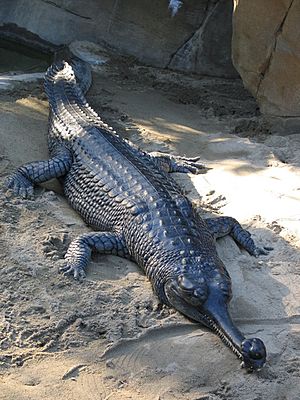Gavialis facts for kids
Quick facts for kids Gavialis |
|
|---|---|
 |
|
| The gharial (Gavialis gangeticus), the only living species of Gavialis | |
| Scientific classification |
|
| Kingdom: | Animalia |
| Phylum: | Chordata |
| Class: | Reptilia |
| Order: | Crocodilia |
| Family: | Gavialidae |
| Subfamily: | Gavialinae |
| Genus: | Gavialis Oppel, 1811 |
| Species | |
|
|
Gavialis is a group of crocodilians that includes the living gharial (Gavialis gangeticus) and several extinct species. These amazing reptiles are known for their very long, thin snouts, which are perfect for catching fish!
Contents
What is Gavialis?
The name Gavialis refers to a special group, or genus, of crocodilians. Crocodilians are a type of reptile that includes crocodiles, alligators, caimans, and gharials. What makes Gavialis unique is their super-long, narrow snout. This snout is full of sharp teeth, making them excellent fish hunters.
The Living Gharial
Today, there is only one living species in the Gavialis group: the gharial (Gavialis gangeticus). This incredible animal lives in the rivers of India and Nepal. Gharials are among the longest of all living crocodilians, with some growing over 6 meters (20 feet) long!
- Where they live: Gharials prefer clear, fast-flowing rivers with deep pools and sandy banks. They love to bask in the sun on these sandy banks.
- What they eat: Their diet is almost entirely fish. Their long, thin jaws snap shut quickly on slippery fish.
- Special snout: The male gharial has a special growth on the end of his snout called a "ghara" (which means "pot" in Hindi). This helps him make sounds and attract females during mating season.
Ancient Gavialis: Extinct Species
Besides the living gharial, there were other species of Gavialis that lived long ago but are now extinct. One example is Gavialis bengawanicus. This ancient gharial lived during the Pleistocene epoch, which was about 2.6 million to 11,700 years ago. Fossils of G. bengawanicus have been found in places like Indonesia. Studying these fossils helps scientists understand how gharials have changed over millions of years.
Protecting Gavialis
Sadly, the living gharial (Gavialis gangeticus) is critically endangered. This means they are at a very high risk of becoming extinct in the wild. Their numbers have dropped sharply due to several reasons:
- Habitat loss: Rivers where they live are being changed by human activities, like building dams or mining sand.
- Fishing nets: Gharials often get caught accidentally in fishing nets.
- Pollution: Water pollution also harms them and their food sources.
Many people and organizations are working hard to protect gharials. They are setting up protected areas, breeding gharials in captivity to release them into the wild, and educating local communities about how to live alongside these amazing reptiles.
Images for kids
See also
 In Spanish: Gavialis para niños
In Spanish: Gavialis para niños


